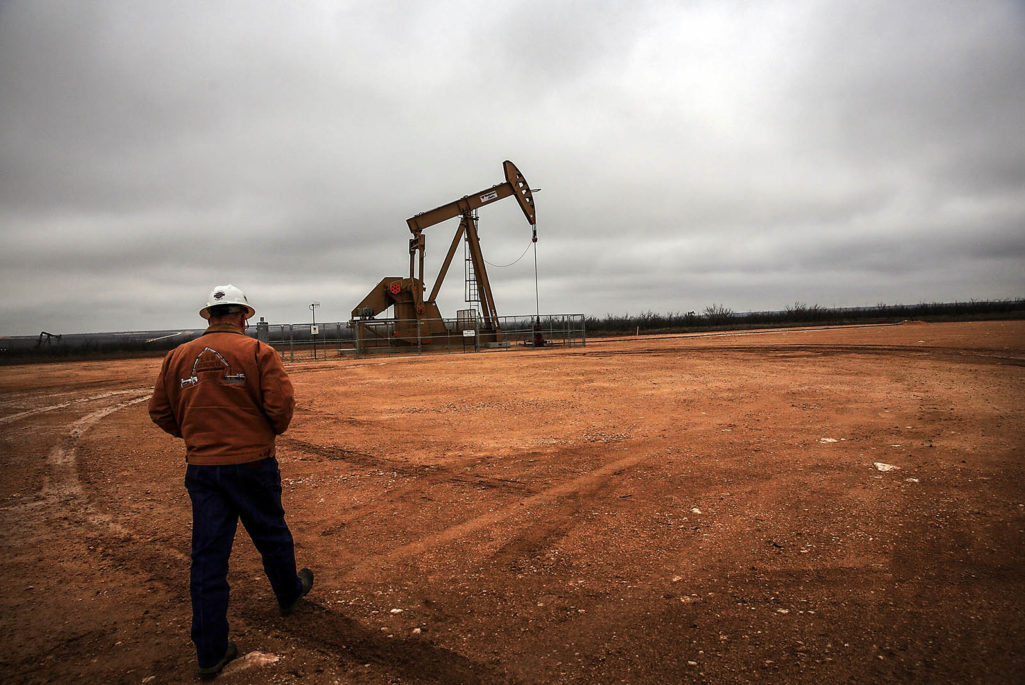Despite End of Export Ban, Rough Seas for Oil and Gas

An oil well owned in the Permian Basin is viewed on February 5, 2015 in Garden City, Texas. The well produces about 55-70 barrels of oil per day. As crude oil prices have plummeted globally, many American communities that became dependent on oil revenue are preparing for hard times. Across the state drilling budgets are being slashed and companies are notifying workers of upcoming layoffs.
Photo: Spencer Platt/Getty Images
When the U.S. Congress voted in December to lift the 40-year-old ban on crude oil exports and President Barack Obama signed that change into law, the landmark legislation capped a year of hurricane-force headwinds for the oil and gas industry. With the price of crude oil—both WTI and Brent—tumbling more than 70 percent from 2014 highs, most, if not all, oil and gas (O&G) companies have had to make hard decisions with short- and long-term ramifications.
In addition to major cutbacks in capital and operational expenditures, most O&G companies have cut permanent and contract staff, totaling more than 250,000 jobs worldwide, according to joint Mercer and Oliver Wyman research and client experience. And while there is an underlying net positive for O&G across the value chain due to the lifting of the ban, it’s not a time for leadership to breathe easy.
While most economists agree that the ability to export crude will lead to greater U.S. production, it is important to understand that the bill alone will have little immediate impact on production levels. Global economic conditions and the global supply-and-demand balance must support and enable crude to be produced, sold, refined or otherwise put into final use to generate energy.
Awash in Oil, In Search of a Market
From a world supply standpoint, we are awash in oil at historic levels. Even if the U.S. can export, it needs to find a market. Oversupply still remains the most critical factor of the current low-price environment. Forward demand, while continuing to increase, is not going to raise the price of crude alone without addressing overproduction. Consider the price of WTI: Open competition will likely cause a nominal rise of WTI while drawing down the price of Brent, essentially eliminating much of the spread between the two and doing little to address—if not exacerbate—“lower [price] for longer.”
While in the short term we see little opportunity, exports may present an advantage in the long term, but companies must be in a position to seize that advantage. With far too many producers unhedged and already net cash-negative for each barrel produced, simply producing more at depressed prices does not change the underlying business fundamentals or change the flow of cash.
In order to seize the advantage of exports and higher production, producers must first optimize their assets and operating models such that they become cashflow positive for every barrel. While significant strides have been made in this area in the past six to ten months, much more is necessary to remain viable in a low-price environment.
Refining or downstream may be equally challenged by the opportunity the ban lift presents, but here, too, the benefits may be on the distant horizon. On a global scale, while light sweet crude could become more abundant, there is significant cost in upgrading assets to process light sweet vs. heavy sour—or both. Consequently, while higher WTI prices challenge U.S. refining margins on one end, it is likely offset by the tax advantages to refiners currently outlined in the bill.
Even if the U.S. can now export oil, it needs to find a market.
Midstream, too, is likely to benefit from more product gathering, storage and movement. Here is the question to consider: Is the current infrastructure adequate, or will significant upgrades and investments be required to safely and reliably transfer product across the country? All told, while there may be tremendous upside, there must be a solution to the oversupply problem before those benefits are realized. These potential gains are well off in the future and, undoubtedly, the fierce waves of a tumultuous sea are not yet calmed.
The Human Capital Perspective
As production, infrastructure, margins and healthy, sustainable business eventually return, we fully expect staffing needs to increase, thereby returning lost jobs and creating new ones across the U.S., in and outside of O&G. Most agree that for every job created in O&G, two to three are created in the general economy.
O&G is historically cyclical and will continue to be so in the future. When, why and how severe the swings will be remain the questions to answer—or at least the questions for which we should prepare.
What should leadership do now in terms of talent or managing human capital? We have long advocated to HR leadership that the very essence of effective human capital strategy and execution is found in workforce scenario modeling and planning. With this change in policy (and other transformative changes known and unknown), the best and right move for HR leadership right now is to partner with business leaders and finance to map out the changes to their business/portfolio and the resulting changes to their workforce—in essence, reshaping the entire enterprise to optimize performance in dynamic market conditions.
Workforce planning remains a capability gap for most organizations. Mercer’s latest O&G Market Disruption survey outlines that 70 percent of respondents neither strongly agree nor disagree, or simply disagree, that their current workforce plans provide managers with the right number of people with the right skills, in the right place and at the right time. Being able to do so is the foundation of good organizational management. Only by doing so can an individual company outline its specific and unique response to changes in the market.
With fundamental workforce needs outlined under various scenarios, HR leadership is challenged to create a balanced strategy, both in how it deploys talent and how it manages, develops and optimizes talent in alignment with organizational performance, as described by Mercer’s latest strategic analysis.
Finally, while political change in the U.S.—now the world’s largest oil and gas producer, a seismic world-energy shift—has potentially great benefit from an operational, financial and workforce standpoint, O&G organizations must balance the potential reward against the underlying workforce headwinds that have not abated.
These include an aging workforce and a “great crew change,” by which Mercer analysis shows that more than 500,000 person-years of experience will leave the O&G workforce in the U.S. and Canada in the coming five years.
In addition, the development time-to-proficiency for critical skill O&G jobs takes a great many years to develop, while the sector still faces a future shortage of critical skills on a global scale. Clearly, and despite the positive outlook generated by the end of the export ban, storms continue for the O&G sector. Managing in the short-term with a long-term view is the way to navigate the sea change.







